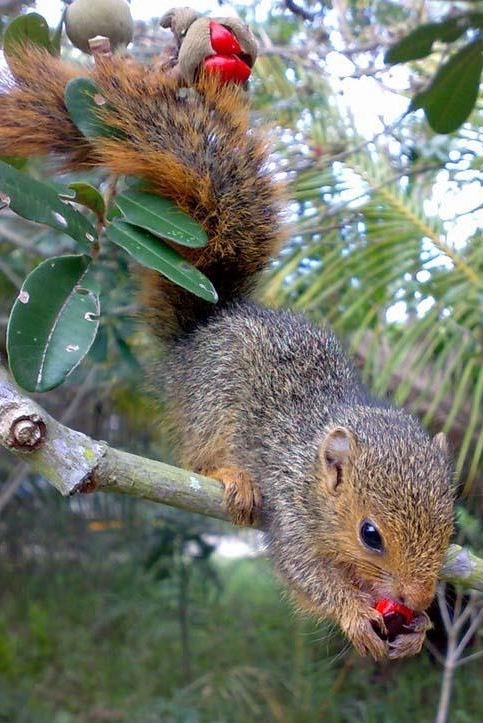The Tongaland Red Bush Squirrel
There are a number of squirrels in Southern Africa, all belonging to the family Sciuridae. The various genera include
Xerus,
Heliosciurus,
Funisciurus and
Paraxerus. The prominent species in South Africa are
Xerus inauris, the Cape Ground Squirrel or South African Ground Squirrel, common in drier western parts of SA,
Paraxerus cepapi, the Smith's Bush Squirrel or locally in SA called Tree Squirrel in the northern parts of South Africa, very common in the Kruger Park. And the third species is the cutest of all:
Paraxerus palliatus, the rare Red Bush Squirrel of Maputaland.
Paraxerus palliatus has a red or orange ventral surface, a rufous head, a deep red tail and a skull length between 45 and 52 mm.
Paraxerus cepapi ha a whitish underside, a dull grey head and its tail is not red at all. It has a shorter skull (between 29 and 45 mm). Their distribution range does not overlap. The Tongaland Red Bush Squirrel only occurs in Maputaland as far south as lake St. Lucia. The tree squirrel is absent from Maputaland.
Red Bush Squirrels prefer sry or moist evergreen forests, thick woodlands or riverine thickets. In dry conditions, they get moisture from fruits, dripping water of leaves or from water in tree holes.
They are arboreal and diurnal. They leave their shelters early in the morning and retire for the night in the early evening. They are generally solitairy, but a female may be accompanied by her young. Temporary associations af a female and a male occurs when the female is in oestrus. The main diet consists of nuts, berries, wild fruits, roots, leaf and flower buds, bark and lichens.
Their home range is between 2 and 3 ha. They focus their activity in fruit-bearing trees.
They are often seen fluffing their tails and have a variety of vocalisations, a murmuring contact call, growling and hissing under stress. Urin dribbling or anal dragging are their olfactory means of communication.
The species is perhaps in need of revision as there are large amounts of variation in size and pelage between isolated populations, and at least seven subspecies are currently recognised, some of which may represent valid species, in SA two subspecies are listed,
P. p. ornatus from
Ngoye Forest and
P. p. tongensis from Maputaland.
National Red List status:
P. p. ornatus Critically Endangered
P. p. tongensis Endangered
Current population trend: Declining, inferred from ongoing habitat loss in the region although there are secure forest habitats in Maputaland.

- Squirrel 2.jpg (268.54 KiB) Viewed 592 times